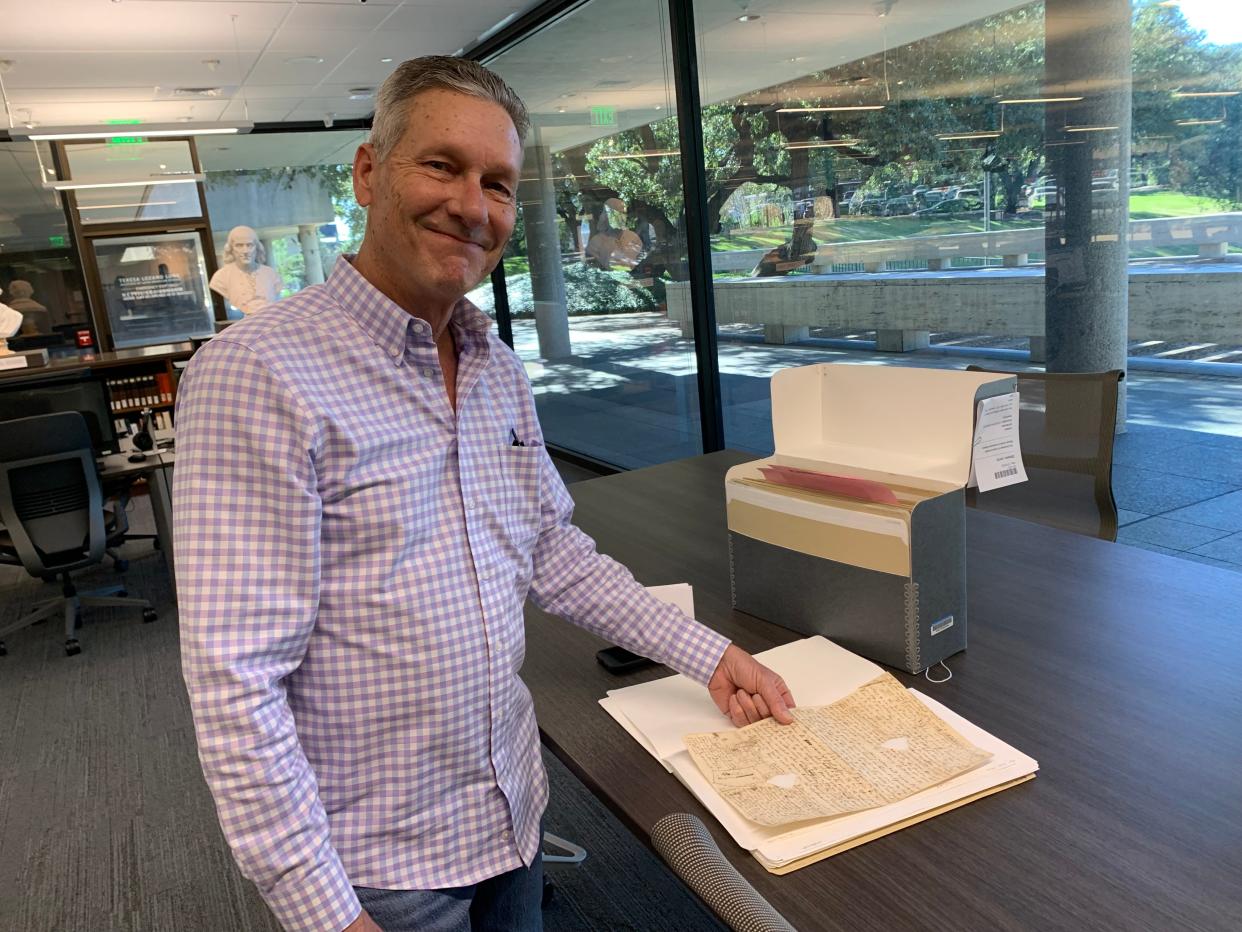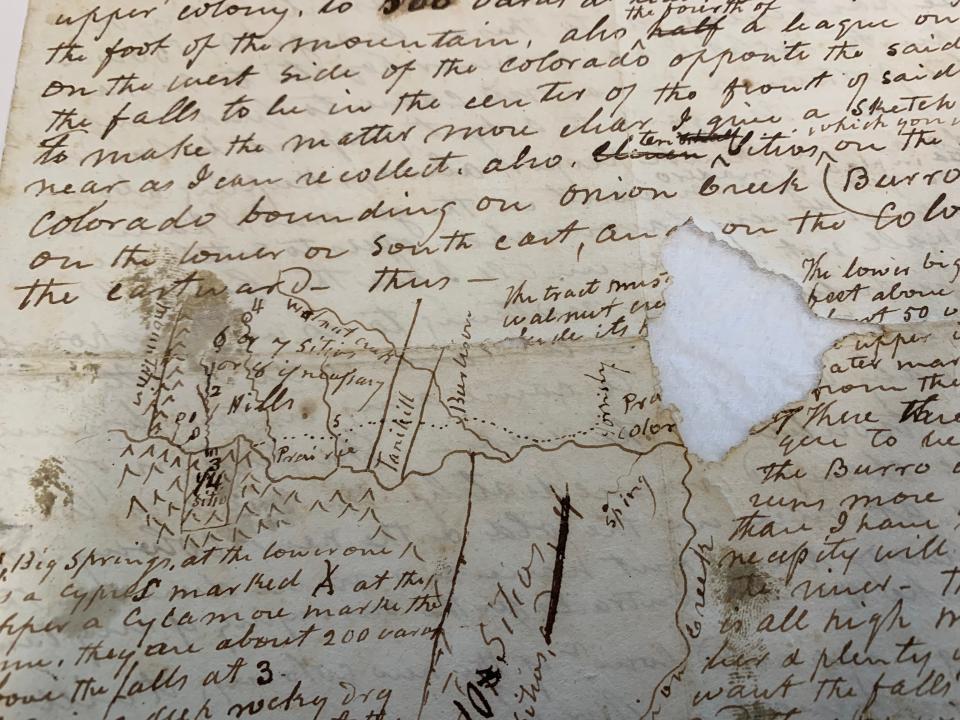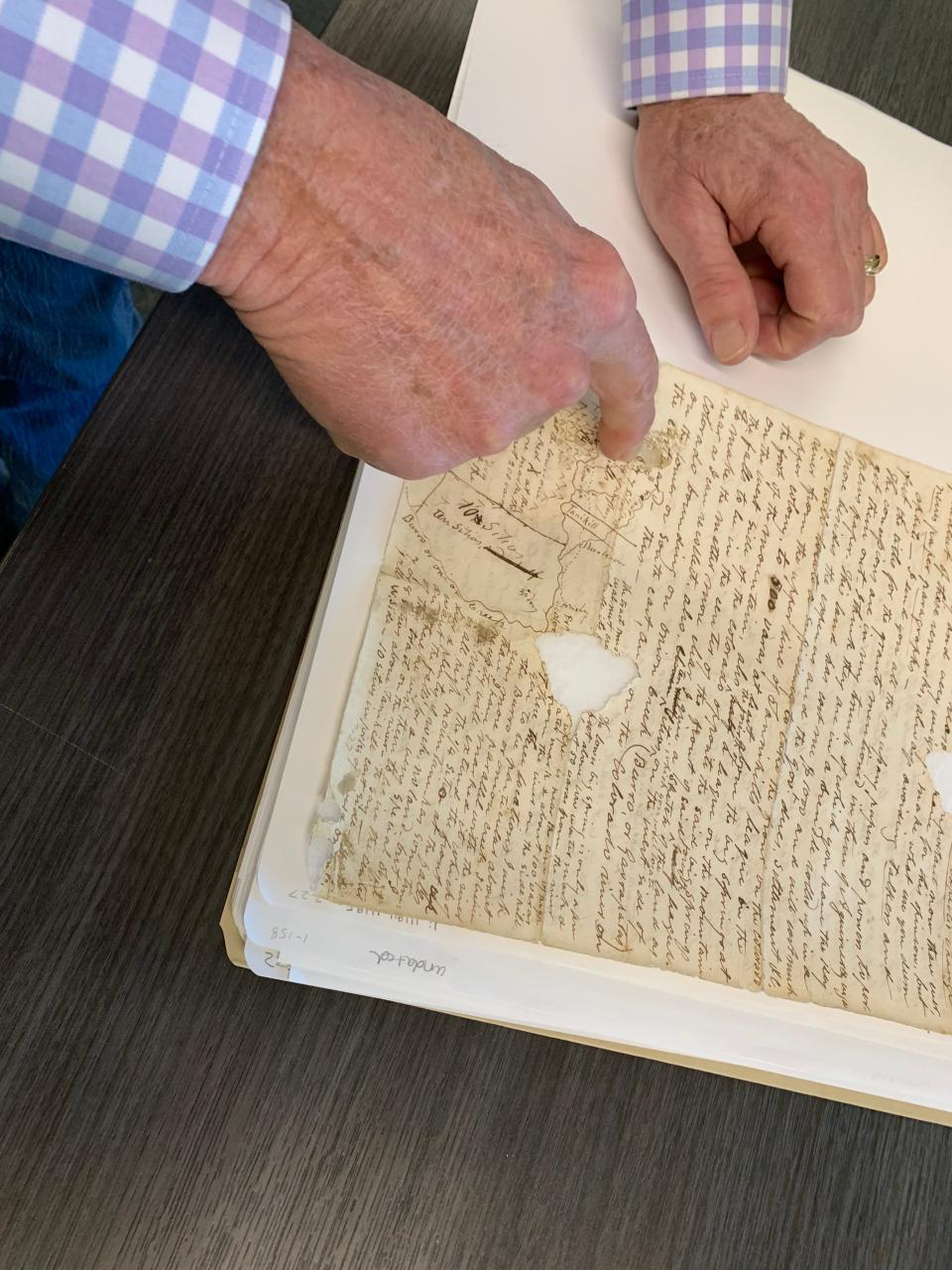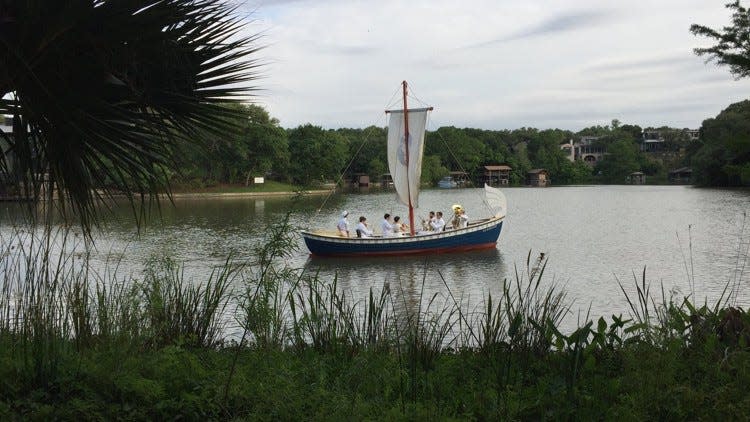'Nobody would ever find him': Stephen F. Austin wanted to retire to what is now Austin

The story can now be told: Stephen F. Austin, leader of American colonists in Texas, wanted to retire to what is now the city of Austin.
Thanks to Lanny Ottosen, whose meticulous research has solved several nagging history mysteries of late, we can be reasonably sure that Austin chose a site at Cypress Springs near the base of the "Colorado Mountains."
In other words, below the Balcones Escarpment at what is now Laguna Gloria.
For years, I've cast doubt on what appeared to be an urban legend: That the museum located at the historic 1915 villa called Laguna Gloria, built by philanthropist Clara Driscoll Sevier on the Colorado River — now Lake Austin — was so peaceful and beautiful, Austin looked forward to retiring there.
The story had been handed down so often that the museum, The Contemporary Austin, regularly includes the claim (without evidence) in its widely circulated literature. And who, except perhaps for a cynical journalist, would not believe that the gorgeous museum grounds, these days a sculpture park recently made more accessible to people with disabilities, had so powerfully attracted Austin?
"The claim began in May 1923," Ottosen writes in an upcoming post for the Travis County Historical Commission Blog shared in advance with this newspaper, "when the Austin Statesman reported that Clara Driscoll Sevier told of her fortunate possession of the site selected by Stephen F. Austin for his last days. From that date forward, the story has been repeated, distorted and occasionally amplified.
"Did Austin ever own the area including Laguna Gloria?" Ottosen continues. "No. He tried but he never secured title to the land. Did Clara purchase the location because it was thought to be where Austin intended to erect a home? No. It would certainly be another historical 'badge' to add to her accomplishments, but it is not the case. The Seviers purchased the tract in 1915 before they knew of Austin’s intentions to settle specifically at that location."
Texas history, delivered to your inbox
Click to sign up for Think, Texas, a newsletter delivered every Tuesday
History buff Ottosen, who serves on the Travis County Historical Commission, was just the man to nail down the convincing evidence. A master of maps, who can read early land grants of the Austin area like the back of his hand, Ottosen found just the right clinching clues at the Briscoe Center for American History at the University of Texas.
An Austin letter and a handy sketch

On a December afternoon, I met Ottosen at the Briscoe Center, along with James Harkins, director of public services for archives and records at the Texas General Land Office. After perusing materials that Austin used to draw his own maps of Texas, Ottosen opened a folder to reveal a yellowed piece of paper. Aside from some holes and tears, it was covered with inky cursive writing and, at the bottom left, a little sketch.
Austin wrote this surviving 1832 letter from Saltillo, Mexico, to his secretary, Samuel May Williams. It included a map and profile of the area.
“To make the matter more clear, I give a sketch of the land as near as I can recollect,” he wrote.
His memories of the area came from a trip that Travis County historian Frank Brown described as such: “Austin, came up with two surveyors and a small body of immigrants,” to explore the Colorado valley above Bastrop in April 1830.
The land from Bastrop to the hills on both sides of the river was by then already known as Austin's Little Colony. Austin had received a grant in 1827 to colonize 100 families in this area, but he did not own this particular tract of land outright.
In his 1832 letter, Austin asked Williams to survey land for him along the Colorado, encompassing “the big springs at the foot of the mountain” and wrote that “I shall fix a place on the Colorado at the foot of the mountains to live and wish for those locations (for) my own use and not to sell ... I want the falls for a very special object and therefore wish them to lie in the center of this tract on the river.”
In the same letter, Austin told Williams to secure a quarter league surrounding what is today Barton Springs. In addition, he selected land that included Waller Creek, Shoal Creek and Bull Creek.
The big springs, however, that Austin described would later become known as Mormon Springs, Cypress Springs or Mount Bonnell Springs, among other names. It is likely that the complex of springs is now under water, near the mouth of the lagoon that gives Laguna Gloria its name.

How to interpret Austin's map
Almost a year after Austin sent the letter with the map to Williams, Austin wrote another letter to his brother-in-law, James F. Perry, that renewed his plans to put down roots on the east side of the Colorado at the foot of the mountains.
The home was to be a "mountain retreat and a large sheep farm."
For the next two years, however, his attempts obtain a title to the land were unsuccessful.
"When Austin died in 1836, his heirs immediately began trying to secure the vast tracts of land he had acquired," Ottosen writes. "One of those was the Colorado River grant. The primary reason, in 1838, that Austin’s brother-in-law, James F. Perry, sent Ed Burleson to lay out Waterloo (the hamlet that became Austin) was not just to lay out the town, but to inspect the grant, lay claim to it and reassure the settlers that when they won claim to it in court, that the Austin heirs would issue titles to the settlers already there."
More:Monte Warden's very Texas family
Yet the 1832 letter did not go public until August 1921 — six years after Driscoll built her villa — when it was reported by several Texas newspapers.
"It had been in a private collection of letters of Mrs. Louise (Hale) Connerly, who had inherited them from her father, William G. Hale, who was a prominent lawyer in Texas after statehood," Ottosen writes. "Mrs. Connerly had loaned the letter to UT archivist Mattie Austin Hatcher who was transcribing Austin family documents. In 1970, Walter Long reported 'Mrs. Connerly was so intrigued that “Miss Clara” had built her home on the location of the — "place" — seemingly described by Stephen that she generously gave the letter to Mrs. Sevier.'"
Searching for more evidence that the "big spring" — Cypress, Mormon or Mount Bonnell — was Austin's domestic destination, Ottosen turned to an 1846 survey of the Daniel Gilbert land grant that included the current site of Laguna Gloria.
"The survey described the southwest corner 'in the river cornering on a Cypress Tree … which stands in the center of a Big Spring,'" Ottosen writes. "This southwest corner is also the southwest corner of the original 28 1/2 acres of tract the Seviers purchased. It is clearly shown on several historical maps, but an 1874 Travis County District Court case dividing the estate of P.C. Taylor includes a plat more detailed than any other map showing the location of the spring and a backwater lagoon."
Evidence of the exact location of the intended retirement spot: On Sept. 14, 1847, Stephen F. Austin’s nephew, Guy Morrison Bryan, wrote to his father James F. Perry. He was on a trip through Austin and other locations, and his letter described his journey. He wrote of a visit to Mount Bonnell and the springs: "Cypress Springs … is a bold clear & prolific spring gushing out all around & from the roots of a large Cypress Tree, the Mormons (had) a settlement here & a Mill.
“Mother (Stephen F. Austin’s sister) told me a little incident yesterday which occurred with Uncle (Stephen F. Austin) some years ago. When harassed with the business and with the turbulent spirits of the colony, he said he would take Simon and go to Cypress Springs (at the foot of Mount Bonnell) and raise sheep, he would there be so far out of the world he knew nobody would ever find him.”
Ottosen writes that that Bryan describes the springs at a cypress tree in nearly the exact same manner as the Gilbert survey and, more importantly, recounts a story told by Austin’s sister that Stephen would “go to Cypress Springs.” A transcription of this letter was published in the Austin Statesman in 1921, about the same time as the 1832 Austin letter.
"Clara obviously had read it, and the 1832 letter, and she likely knew the corner of the Laguna Gloria tract was Cypress Springs," Ottosen writes, "so she honestly did have the bragging rights to the story."

Austin letter a badge of honor
"Driscoll was so proud of the 1832 letter that the framed original hung in the entrance to Laguna Gloria and she thought it so important that when she donated the Laguna Gloria property to the Texas Fine Arts Association in 1943, she donated the letter with the property," Ottosen writes. "It appears the original letter remained there until about 1953, as that is the last newspaper report of its display there."
In 1962, when Walter Long (who served for 35 years as manager of the Austin Chamber of Commerce and is known as the father urban planning in Austin) was writing "Stephen F. Austin’s Legacies," he asked the Laguna Gloria Museum about the original letter. Museum leaders sent a copy, after saying the original had been lost.
"Miraculously, the original letter is now in the Moses and Stephen F. Austin papers at Briscoe Center," Ottosen writes. "The center has no record of who donated it, so how it went from Laguna Gloria to Briscoe is a mystery, but it survives."
Each of the three dams that created Lake McDonald, now called Lake Austin, submerged the original point identified on the Gilbert Survey as the "Big Spring" and the "Cypress Tree."
"Today, that point lies beneath Lake Austin southwest of Laguna Gloria," Ottosen writes. "Like many springs in the Texas Hill County, Mormon Springs is not a single isolated discharge point but complex of multiple springs in that area that include springs that can be seen when lake levels are reduced exposing discharge points along the shore north of Laguna Gloria."
LCRA’s next planned lowering of lake levels for dock repair is in 2024. That might present an opportunity to visit the springs, a history excursion I'd love to make.
Austin, who worked on behalf of the American colonists while remaining loyal to Mexico until that loyalty was no longer tenable, died before he could retire. He spent his last months serving as secretary of state for the new Republic of Texas. He died in that service in Columbia, Texas, on Dec. 27, 1836, at age 43.
He was buried at his sister's home at Peach Point Plantation near Jones Creek, Texas, but was reinterred in 1910 on the "Hill of Heroes" in the Texas State Cemetery in Austin.
Michael Barnes writes about the people, places, culture and history of Austin and Texas. He can be reached at mbarnes@gannett.com. Sign up for the free weekly digital newsletter, Think, Texas, at statesman.com/newsletters.
This article originally appeared on Austin American-Statesman: Laguna Gloria was where Texas' Stephen F. Austin wanted to retire

